#monk calligraphy
Explore tagged Tumblr posts
Text

A prayer in ink Otagi Nenbutsu-ji Temple [愛宕念仏寺] Kyoto (京都), Japan
Aleksandra Alba IG:tanzdreamer
#my photography#goshuin#goshuincho#御朱印#御朱印帳#japanese calligraphy#spiritual journey#sacred ink#calligraphy#japan#kyoto#buddhism#shinto#monk calligraphy#temple#japanese buddhism#愛宕念仏寺#Otagi Nenbutsu-ji#京都#日本#black and white#books#reading#mine
51 notes
·
View notes
Text

Bodleian Library MS. Ashmole 304 f.47v
Three smiling bat doodles with script (proto gothic?)
Drawn by Matthew Paris, monk at Saint Albans.
#medieval manuscripts#middle ages#medieval#cloistercore#monkposting#bat#medieval monk#illuminated manuscript#calligraphy#manuscript
672 notes
·
View notes
Text
monk memes pt.4?
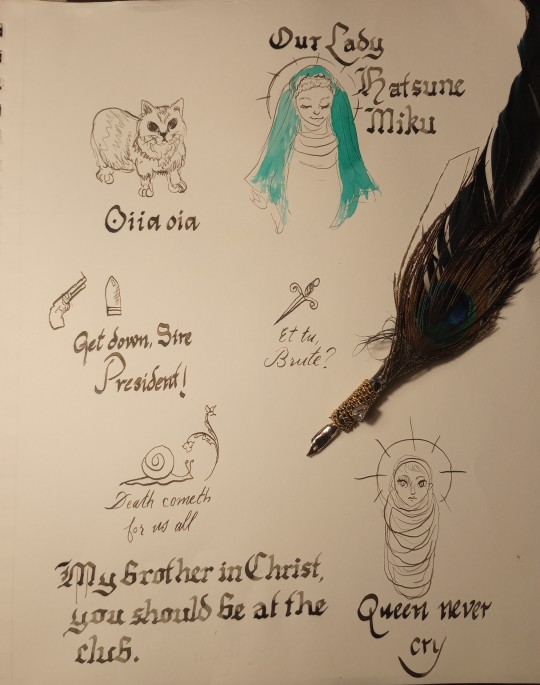
388 notes
·
View notes
Text
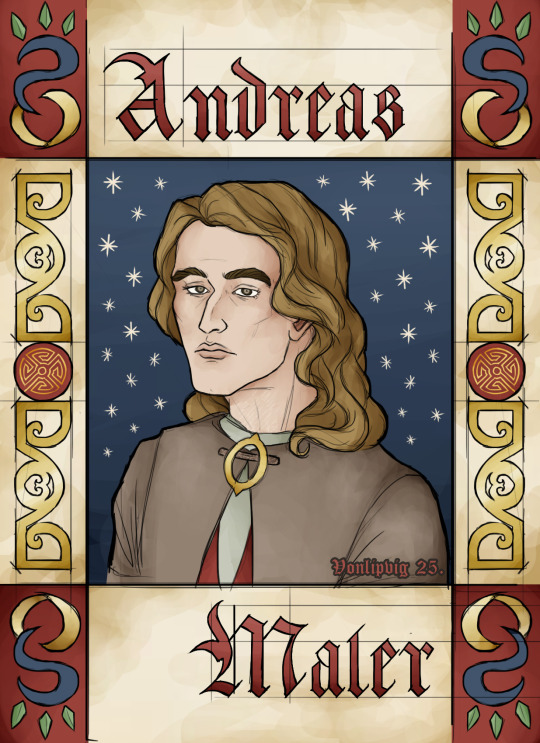
andreas maler kinda the guy of all time so i had to doodle something real quick because i'm also an artist with a bunch of issues
#pentiment#andreas maler#my art#this is another glorified doodle but i had so much fun ngl#calligraphy aaaaa i did have fun i should have been a monk#anyway andreas.........guy of all time fr
102 notes
·
View notes
Text
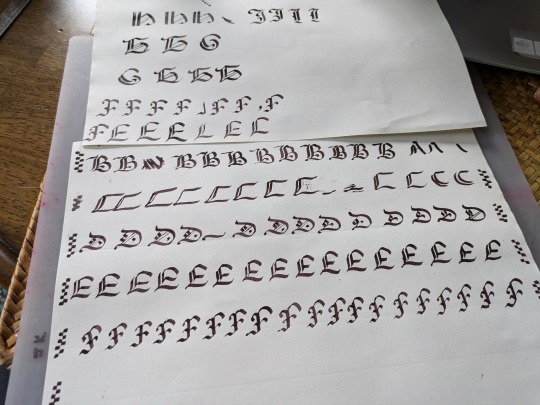
I've discovered the secrets to not smearing my ink as a lefty. - Skip lines and come back to them later when dry. - Go incredibly slow and take breaks between lines. - Right lines Left to Right. ....I need better secrets, but for practicing my Rotunda majiscules (capitals) filling out pages at a glacial pace will suffice.
#calligraphy#lefty calligraphy#Blackletter#Rotunda#medieval#It's Spring so I'm in full Little Medieval Guy mode#Sitting in my little scriptorium (the dining room) with my fellow monks (my cat) listening to the rain fall.#I should do a page with my quills but I really need a better tilted board setup than propping my work surface up with a book#Specifically Umberto Eco's The Name of the Rose#Just as they would have done in the 14th century.
11 notes
·
View notes
Text

“When the old plum tree suddenly opens, the world of blossoming flowers arises. At the moment when the world of blossoming flowers arises spring arrives. There is a single blossom that opens five blossoms. At this moment of a single blossom, there are three, four, and five blossoms, hundreds, thousands, myriads, billions of blossoms, countless blossoms. These blossomings are not-being-proud-of one, two, or countless branches of the old plum tree... Blossoming is the old plum tree’s offering.
The old plum tree is within the human world and the heavenly world. The old plum tree manifests both human and heavenly worlds in its treeness. Therefore hundreds and thousands of blossoms are called both human and heavenly blossoms. Myriads and billions of blossoms are buddha-ancestor blossoms. In such a moment, "All the buddhas have appeared in the world is shouted, "The ancestor was originally in this land" is shouted.”
— Eihei Dogen. Song era. Studied as a monk in 5 of the different sects of Chan Buddhist Monastic Universities of the time in China, and returned to open his own school in Japan. Dogen was a prolific and inspired author. z Is considered the first ancestor of the Soto lineage.
#song dynasty#history#monk#calligraphy#calligrapher#spirituality#art#literature#poetry#meditation#philosophy#writing#books#Dogen#zen#Chan#Soto
14 notes
·
View notes
Text



recent request from my friends
(random shit from our dnd sessions, a meme, and a quote from a fic)
#letters from the void#calligraphy#the medieval monk that possesses me to do this shit#wasn't exactly sure what an axolotl was#but i think we managed
4 notes
·
View notes
Text
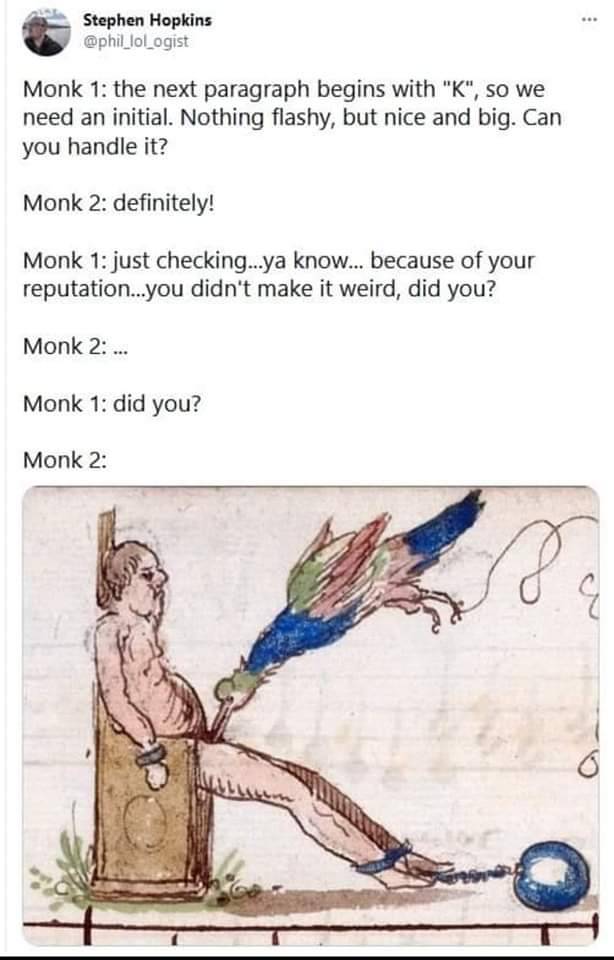
So is that K for Kingfisher or peacocK?
4 notes
·
View notes
Text
so did any of you freaks also sort of enjoy church as a child because you hyperfixated on some of the new testament bible stories, like as works of fiction. not fiction in a 2004 reddit way but fiction as in compelling storytelling media that may or may not might also be a true story. as if an intense fixation couldn't already be a borderline spiritual experience in itself, also thinking these figures were real and present and celestial yet human beacons of love and life and compassion and hope. i think maybe every monk was on the spectrum
#LMFAOOO#i say on the spectrum but i'm talking about being adhd#but the adhd hyperfixation and autistic special interest fixation can be indistinguishable at times#like copying down a book over and over with fancy calligraphy and illustrations because you love it so much#is something an adhd or autistic would do. that particular behavior pattern is shared across the board#that's maintaining a wikipedia article at the VERY least#just being in a monks study with inks and tomes working away on your special passion is very favorable for any adhd or autistic#particularly if youre hyperactivity is of the mental type not physical
4 notes
·
View notes
Text
LEGEND OF NEVETSECNUAC - TRIP TO THE MONASTERY - SECTION 2
LEGEND OF NEVETSECNUAC – TRIP TO THE MONASTERY- SECTION 2 LEGEND OF NEVETSECNUAC – THE TRIP TO THE MONASTERY – SECTION- 2 Anticipating tad spare time before their so-called admittance to the grounds, Stark, dawning a patient, placating smile, succinctly and in measured tone next imparted to Teuquob of the fierce struggle that had lasted for more than two hundred years of Wenjenkun’s history…

View On WordPress
#Abbot Boqast Tizanzenn#calligraphy#devout#disciple#fare#God#Heaven&039;s Gate Spiritual temple#list#monks#novice#pilgrims#prayer#priests#religious sects#religious wars#ritual#salvation#temple#trek#warfare
0 notes
Text
Nosferatu’s Contracts: A Linguistic Deepdive
(This is one half of a blogpost I put on my website! Read the full thing for a full list of sources and even MORE information on the contract from the 1922 film).
So I saw the new Nosferatu film the other day and while I didn't think it was all that fantastic (I loved the first half okay, calm down) the one thing that did stick out to me was the absolutely gorgeous scripts used for the contract that Thomas has to sign. Thank you to this Reddit post for sharing a picture of the entire thing:

The BEAUTIFUL red calligraphy is called Vyaz, a form of decorative Cyrillic calligraphy. In Vyaz script, letters are all joined and interwoven together to create a beautiful, ornamental typographical piece. The Wikipedia page about it is fucking pathetic but it does feature this example of text with a coloured breakdown of the individual words that comprise the piece:

Obviously this itched my language brain like crazy. The best resource I have found since to learn more about Vyaz is this full, free guide written by Viktor Pushkarev. He has also released a 254 page PDF for 25 euros called the Modern Slavic Vyaz Calligraphy Workbook and I think I'm going to have to buy it. His examples look stunning and I would love to learn more about this style of calligraphy. Thank you, Nosferatu.


The Vyaz calligraphy is only one style of writing used in that contract. The other is a completely different style of writing and, surprisingly (or not, maybe?) the best place to look for answers turned out to once again be Reddit. This commenter suggests it's another form of Cyrillic:

Here's some Glagolitic, to compare:

In a different thread, this commenter claims to have cracked it:


This commenter replies with an addition:

So that's cool! In that same thread, this commenter says that the contract looks like a Romanian hrisov, or medieval chancellery charter, and recommends this video explaining how they were written. As you can see from the example below that the commenter shared, these traditional contracts look pretty damn similar to Orlok's contract! So let's talk about them real quick, because it's interesting!

The video is by Adrian Gheorghe, a historian whose speciality is the editing and translation of all documents regarding Vlad the Impaler. He talks about how unlike letters, which would be written in Latin, these charters were written in Slavonic, a liturgical and "literary language, based on Slavic dialects of the Balkans, developed by monks in the 9th century" (X). Viktor Pushkarev suggests a book called Grammar of the Church Slavonic Language if you want to learn more about the grammar and syntax. Slavonic was often written in Glagolitic and hey, we've seen that before!

These charters also had explicit and strict structures that they adhered to. This strict standard served to not only prove the legitimacy of a document, but that "the document was drawn up with all due solemnity" (X). Interestingly, each charter would invoke God in the opening lines or would simply have a cross at the beginning, and according to the translations given above Count Orlok's contract does not seem to include this. I recommend checking out the video in its entirety to hear more about this cool bit of history.
But of course... that's not all that's written on the contract, is it? Thomas signs it, and he signs it in Kurrent script, an old traditional form of German cursive. If you'd like to learn how to write in Kurrent, there's a free guide by Margarete Mücke right here! Here's a screenshot I took of the scene along with a Kurrent alphabet for comparison:


Kurrent has a really interesting history. It evolved from gothic cursive at the beginning of the 16th century, which saw a lot of use in the medieval ages. Compared to the vast variety of gothic cursive writing styles, Kurrent was "beautiful, fast to write and comparatively legible" (X). It soon moved out of use solely in chancelleries and into everyday use, becoming more and more standardised.
This script saw a bit of a rollercoaster of popularity; in the early 1900s it was established and taught in all German schools, then steadily became seen as "antiquated and ugly", then the Nazis declared other writing scripts "Un-German" and promoted gothic typography until 1941 when Hitler declared Kurrent and its sister writing style Fraktur "to be of 'Jewish origin' and therefore taboo". More information about this can be found on this page about the history of Old German Script (another name for Kurrent).
So that's that! Count Orlok's contract is based on traditional charters of the region with set structures to highlight their legitimacy and importance as documents, using traditional scripts and handwriting of the time, and is also a style of document that is directly tied to Vlad the Impaler, the inspiration for Dracula and ultimately Nosferatu. Extremely cool and also totally makes sense considering Robert Eggers interest in authentic linguistic detail (like I didn't even mention the language that Orlok speaks throughout the film, which is Dacian, an extinct ancestor of Romanian). Lots of really tasty stuff to look at and I had a blast putting it all together.
Except.......... it's not the end. There's a whole second saga to be told about the contract from the 1922 film, and if you wanna read that (I get deep into talking occult symbols and angel languages) you're gonna have to read the original post on my site!

548 notes
·
View notes
Text
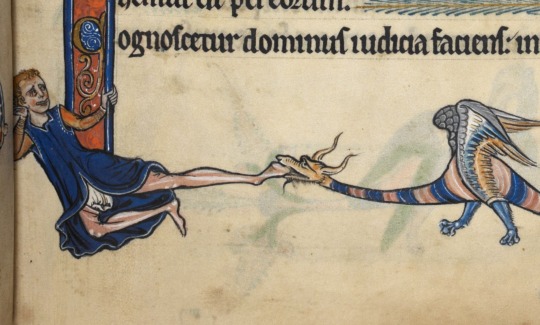
A man getting his feet licked by a wyvern
British Library Add MS 62925 f.14r
#medieval#medieval manuscripts#middle ages#illuminated manuscript#the mediaeval monk#cloistercore#medieval core#calligraphy#medieval monsters#meme
74 notes
·
View notes
Text

648 notes
·
View notes
Text
@yunisverse

little commission for a friend over in discord of an OC named Ondan! Very fun to do!
#Ondan#my absolute beloved#the powerful and graceful bard monk#toonkind dnd#i love this pose so much#and the orange fan pattern is a gorgeous choice#i love the flames - they feel like calligraphy and i'm not over that#this is so gorgeous#this is wild#i dont have a lot of pictures showing a monk-ish side of Ondan but i'm glad this exists
36 notes
·
View notes
Text
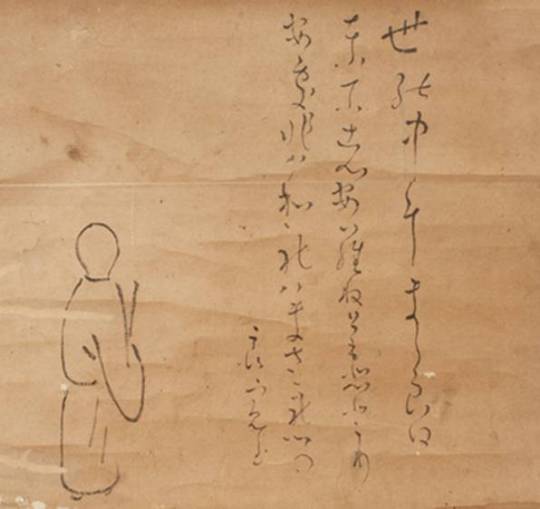
あ と 世 そ に の び は 中 ハ あ に わ ら ま れ ね じ は ど ら 良 ま も ぬ 寛 さ ひ 書 れ と る り
"It is not that I avoid mixing With this world; Better for me is enjoying Life on my own. "
Brushed by Ryokan, a wandering zen monk, who slept with a stone for a pillow, wore a torn robe, and carried only a begging bowl, but was renowned as one of the greatest calligraphers who ever lived.
#ryokan#calligraphy#art#japanese#zen#buddhism#monk#painting#history#meditation#literature#spirituality#art history#japan#ink#brush#haiku
45 notes
·
View notes
Text


On this day:
VOYNICH MANUSCRIPT: MOST MYSTERIOUS MANUSCRIPT IN THE WORLD
On August 19, 1666, the rector of Prague University sent a letter and a manuscript to one of his former students, the Jesuit scholar Athanasius Kircher. The manuscript had lain forgotten in the monastery library in Frascati, Italy, for 250 years. It was obtained by Wilfred Voynich in 1912 and went on to be dubbed "the Most Mysterious Manuscript in the World."
Christened the Voynich, the six-by-nine-inch parchment codex appears to be a straightforward book. It is, however, over two hundred pages written in a code or unknown language that has never been deciphered. The text is elaborately illustrated with colored drawings of unknown plants and the sun, moon, and stars. Depictions of tiny naked women also frolic over the pages.
First appearing in history in 1586, the book was purchased for a then-outrageous sum of 600 ducats by the Holy Roman emperor, Rudolf II of Bohemia. One of the most eccentric European monarchs of the era, Rudolf collected dwarfs, had a regiment of giants in his army, and entertained all manner of magicians and alchemists. It has been suggested that the Voynich manuscript is the work of Roger Bacon, a famous English monk and scientist, and that it made its way to Prague via John Dee, a famous occultist of the time.
From dating of the vellum, pigments, calligraphy, and drawings, the manuscript is judged to be from the late thirteenth century. It has been labeled as everything from an illustrated herbal, to an alchemical treatise written in code to protect the contents, to an elaborate hoax. Its contents are roughly thought to be divided into sections of astronomy/astrology, biology, cosmology, pharmaceuticals, and recipes. After Voynich's widow died, the manuscript was sold to a book dealer and then donated to Yale University.
Text from: Almanac of the Infamous, the Incredible, and the Ignored by Juanita Rose Violins, published by Weiser Books, 2009
258 notes
·
View notes